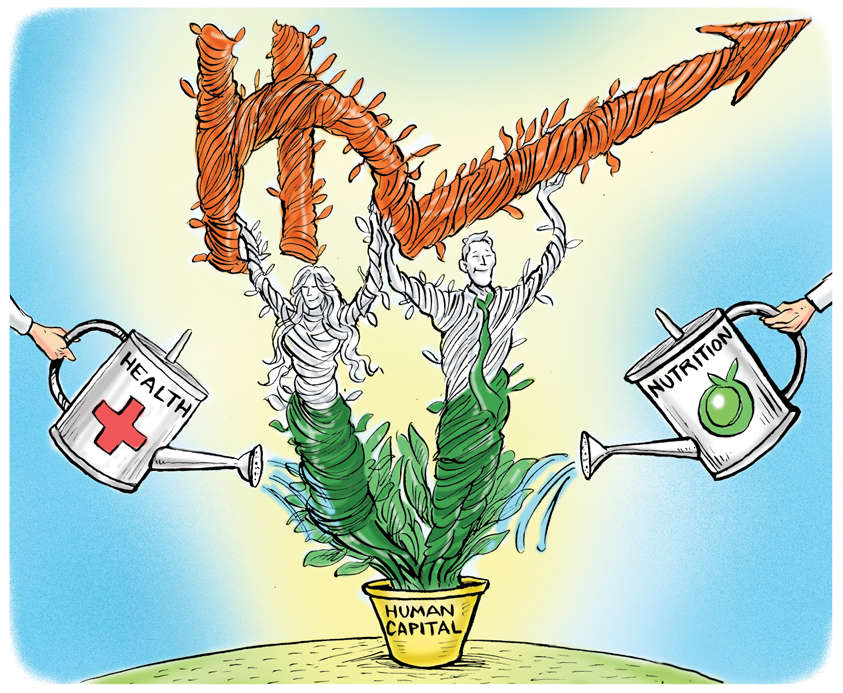Undernutrition is a serious public health problem that has a negative impact on health and the economy, particularly in India. Early stimulation and nutrition interventions in infants and young children lead to better adult outcomes. India has a low Human Capital Index and high rates of stunting, anaemia, and malnutrition. There is evidence that investing in maternal and early-life nutrition yields high returns on investment.

Undernutrition has a negative impact on health and the economy.
- Child deaths: Undernutrition kills 3.1 million children each year, accounting for 45 percent of all child deaths.
- Significant stunting In India, for example: Despite marginal improvement over the years, India has unacceptably high levels of stunting (35.5 percent).
- Stunting has an impact on per capita income: Two-thirds of India’s current workforce is stunted, resulting in enormous economic costs in the form of lower per capita income. The average reduction in per capita income for developing countries is 7%, with India experiencing a high of 13% due to high rates of stunting.
- India’s economic losses due to wasting are estimated to be more than US $48 billion in terms of lifetime lost productivity.
- Another complicating factor is anaemia, which affects 57% of young women and has long-term consequences for future pregnancies and childbirth. When infants are fed inadequate diets and there is insufficient sanitation and hygiene, the situation worsens.
Investing in the health of women and children is a successful strategy.
- Investing in Early Childhood Development: Evidence suggests that every additional dollar invested in high-quality early childhood programmes generates a return of $6 to $17.
- Better future earnings: Early stimulation in infants has been shown to increase future earnings by 25%. Childhood stunting results in impaired brain development, lower cognitive skills and education, and lower future earnings.
- For example, children who are stunted earn 20% less as adults than children who are not stunted, according to estimates.
Increased investment in human capital brings economic growth
- Human capital is the real wealth: The human capital is the wealth of nations and is dependent on the health, nutrition, skills, and knowledge of people.
- Evidence suggests that investing in the well-being of women and children is an effective strategy for improving child outcomes.
- The Human Capital Index ranks India 116th out of 174 countries, with a score of 0.49 indicating that a child born in India will be 49 percent productive if provided with a complete education and good health.
- Education: Education for children is critical to building human capital, increasing productivity, and promoting economic development. It has been proposed to focus on the 1000-day period from conception to two years of age in order to improve birth and nutrition outcomes.
Combining nutrition-focused interventions with nutrition-conscious programmes
- Interventions based on nutrition: Water, sanitation, and hygiene (WASH) interventions focus on the underlying determinants of stunting because poor sanitation can lead to stunting.
- Integrated water and sanitation improvement programme: Evidence suggests that an integrated water and sanitation improvement programme in rural India can reduce diarrhoea episodes (3-50%) in the short and long term. WASH can make a significant difference in combating childhood malnutrition and are important determinants of stunting.
- Nutrition of pregnant women and young children: Studies show that improving the nutrition of pregnant women and young children has a long-term impact on adult human capital and health.
- For example, the first 1000 days of life are critical for rapid growth and development, and poor nutrition can have long-term consequences. This is a critical window of opportunity because stunting begins during this time and worsens by the age of two.
According to Disparities in Undernutrition Prevalence Data (NFHS 5)
- India has more stunted children in rural areas than in urban areas, possibly due to socioeconomic differences.
- Stunting prevalence varies according to mother’s education and household income. There is wide variation across regions, with high rates of stunting in Meghalaya (46.5 percent) and Bihar (42.9 percent), and low rates in Sikkim and Puducherry (22.3 percent and 20 percent, respectively).
- Stunting prevalence varies significantly across states and districts.
Way ahead
- Investing in healthcare facilities is critical for improving India’s productivity, economic growth, and security.
- Undernutrition must be addressed if India is to produce and retain a healthy, highly skilled workforce.
- In order to improve public health and achieve economic growth in India, cost-effective investments in child health, nutrition, and education are required.
@the end
A nation’s true wealth is its healthy human capital. Undernutrition is a major public health concern in India, affecting not only the well-being of women and children but also having negative economic consequences. As a result, addressing undernutrition is critical for developing a healthy, skilled workforce, as well as ensuring India’s economic growth and security.
Source: https://www.orfonline.org/research/the-importance-of-nutrition-in-building-the-human-capital/
